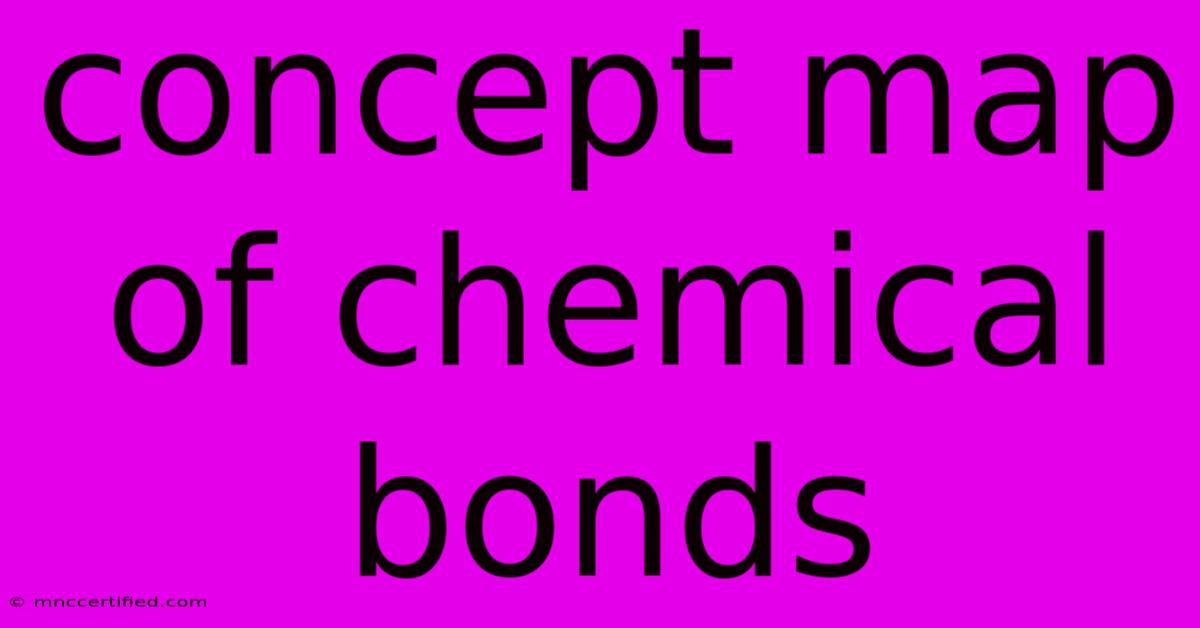Concept Map Of Chemical Bonds

Table of Contents
Concept Map of Chemical Bonds: A Visual Guide to Atomic Interactions
Understanding chemical bonds is fundamental to grasping the behavior of matter. This concept map provides a visual and structured overview of the different types of chemical bonds, their characteristics, and examples. Mastering this concept is crucial for success in chemistry, and this guide will help you build a strong foundation.
Types of Chemical Bonds: A Hierarchical Overview
The primary classification of chemical bonds divides them into two main categories:
1. Intramolecular Bonds (Bonds within molecules):
These strong bonds hold atoms together within a molecule. They are responsible for the molecule's structure and properties. We can further subdivide these into:
-
a) Ionic Bonds: These bonds form through the electrostatic attraction between oppositely charged ions. One atom donates electrons (becoming a positively charged cation) while another atom accepts electrons (becoming a negatively charged anion).
- Example: NaCl (Sodium Chloride, common table salt). Na loses an electron to become Na+, and Cl gains an electron to become Cl-.
- Key Characteristics: High melting points, often soluble in water, conduct electricity when dissolved or molten.
-
b) Covalent Bonds: These bonds involve the sharing of electrons between atoms. Atoms achieve a more stable electron configuration by sharing electrons to complete their valence shells.
- Example: H₂ (Hydrogen gas), O₂ (Oxygen gas), H₂O (Water).
- Key Characteristics: Lower melting points than ionic compounds (generally), can be soluble or insoluble in water, generally poor conductors of electricity. Sub-categories include:
- i) Nonpolar Covalent Bonds: Electrons are shared equally between atoms of similar electronegativity.
- ii) Polar Covalent Bonds: Electrons are shared unequally between atoms of different electronegativity, creating a dipole moment.
-
c) Metallic Bonds: These bonds occur in metals and involve the delocalization of electrons. Electrons are free to move throughout the metal lattice, creating a "sea" of electrons.
- Example: Iron (Fe), Copper (Cu), Gold (Au).
- Key Characteristics: High electrical and thermal conductivity, malleability, ductility.
2. Intermolecular Forces (Bonds between molecules):
These are weaker forces of attraction that exist between molecules. They influence the physical properties of substances like boiling point and melting point. These include:
-
a) Hydrogen Bonds: A special type of dipole-dipole interaction involving a hydrogen atom bonded to a highly electronegative atom (like oxygen, nitrogen, or fluorine) and another electronegative atom.
- Example: Water (H₂O), DNA.
- Key Characteristics: Relatively strong compared to other intermolecular forces.
-
b) Dipole-Dipole Interactions: Attractive forces between polar molecules due to the partial positive and negative charges.
- Example: Acetone (CH₃COCH₃).
-
c) London Dispersion Forces (LDFs): Weakest intermolecular forces, present in all molecules, arising from temporary fluctuations in electron distribution.
- Example: Noble gases, nonpolar molecules like methane (CH₄).
Creating Your Own Concept Map
To solidify your understanding, try creating your own concept map. Use the information above as a guide, but don't be afraid to add your own details and examples. Here are some tips:
- Central Idea: Place "Chemical Bonds" in the center.
- Main Branches: Create branches for "Intramolecular Bonds" and "Intermolecular Forces."
- Sub-Branches: Further subdivide these branches based on the types of bonds listed above.
- Keywords & Examples: Use keywords and specific examples for each type of bond to reinforce your learning.
- Visual Aids: Use different colors, shapes, and sizes to make your concept map visually appealing and easy to understand.
SEO Optimization and Keyword Strategy
This article incorporates several SEO best practices:
- Keyword Targeting: Uses relevant keywords throughout the text, including "chemical bonds," "ionic bonds," "covalent bonds," "metallic bonds," "intermolecular forces," "hydrogen bonds," "dipole-dipole interactions," "London dispersion forces," and "concept map."
- Header Structure: Employs a clear header structure (H1, H2, H3) to organize the content and improve readability for both users and search engines.
- Readability: Uses clear, concise language and avoids jargon where possible, making it accessible to a broad audience.
- Internal Linking (potential): While not included here, you could link this article to other relevant articles on your website about specific types of chemical bonds or related chemistry topics to improve navigation and SEO.
- External Linking (potential): Consider adding links to reputable chemistry resources (but avoid direct downloads) to enhance credibility.
By understanding and implementing these strategies, you can create high-quality, SEO-optimized content that ranks well in search engine results and helps users effectively learn about chemical bonds. Remember to consistently update your content and incorporate new relevant keywords over time to maintain top rankings.

Thank you for visiting our website wich cover about Concept Map Of Chemical Bonds. We hope the information provided has been useful to you. Feel free to contact us if you have any questions or need further assistance. See you next time and dont miss to bookmark.
Featured Posts
-
Yellow Fog Warning Louth And Meath
Nov 28, 2024
-
Stellantis Cheshire Plant Avoids Closure
Nov 28, 2024
-
Flooding In London Storm Conall Warning
Nov 28, 2024
-
Hull City Parts Ways With Tim Walter
Nov 28, 2024
-
Barry Bonds Rookie Card Price
Nov 28, 2024